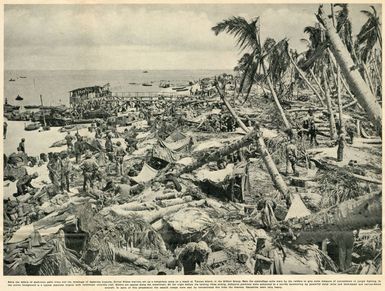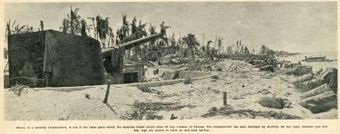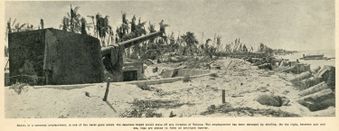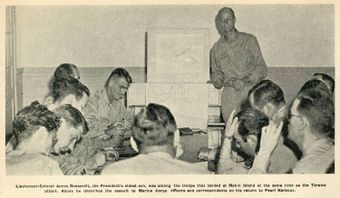Americans strike hard in Central Pacific with landings on strongly-defended Gilbert Islands
- Description:
- Scene of devastation on Tarawa after bitter resistance ended in Japanese defeat. Amid the debris of shell-torn palm trees and the wreckage of Japanese dugouts, United States Marines set up a temporary camp on a beach at Tarawa Island, in the Gilbert Group. Note the camouflage suits worn by the raiders to give some measure of concealment in jungle fighting. In the centre foreground is a typical Japanese dugout with reinforced concrete roof. Others are spaced along the waterfront. On the night before the landing these strong, defensive positions were subjected to a terrific hammering by powerful naval units and land-based and carrier-borne aircraft. In spite of this preparation the assault troops were met by concentrated fire from the beaches. Casualties were very heavy.
- Display date:
- 1943-12-29
- Location:
- Kiribati
- Collections:
- Auckland Weekly News
- Content partner:
- Auckland Libraries
- Availability:
- Not specified
-
Copyright status: Share, modifyFind out more about what you are able to do with this itemMore informationAuckland Libraries has this to say about the rights status of this item:
No known copyright restrictions
What can I do with this item?Non-infringing useNZ copyright law does not prevent every use of a copyright work, and this item may be hosted by an international institute or organisation. You should consider what you can and cannot do with a copyright work.Share itThis item is suitable for copying and sharing with others, without further permission.Modify itThis item is suitable for modifying, remixing and building upon, without further permission.Check about commercial useYou'll need to confirm with the copyright holder using this item for commercial purposes.
Related items
Welcome and warm Pasifik greetings
The information on this site has been gathered from our content partners.
The names, terms, and labels that we present on the site may contain images or voices of deceased persons and may also reflect the bias, norms, and perspective of the period of time in which they were created. We accept that these may not be appropriate today.
If you have any concerns or questions about an item, please contact us.



